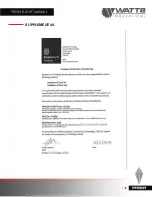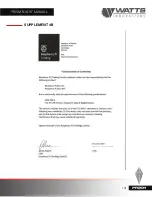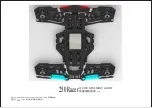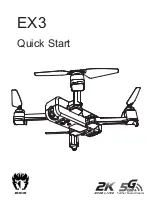
PRISM FLIGHT MANUAL
131
CAUTION:
When operating in cold environments, the tablet battery may not hold charge as expected. The
PIC should pay close attention to the battery levels of the RPS as a whole when operating in
cold environments. Low battery on the RPS may lead to control link loss and failsafe conditions.
Consider applying DC power in the field when operating in the cold.
After any repair work, alterations, firmware update or unscheduled maintenance has been
performed, a test flight must be conducted before the RPAS may be deemed serviceable.
This test flight should take place under the following conditions, in order to minimize injury
to persons or damage to property or equipment.
• PIC to conduct a thorough preflight inspection
• Test flight area should be set up to ensure operations take place with a 50m buffer
between RPA and all persons and property not involved.
• Where possible, attach a dummy payload to simulate the normal payload weight.
The test flight should be conducted as per the following recommendations.
• Select Altitude Hold mode.
• Take off and hover RPA just out of ground effect.
• Confirm that RPA is able to maintain position, altitude and heading without PIC input
(RPA is not excessively drifting, bobbing or rotating)
• Enter Position Hold mode, confirm the RPA holds position and heading (no “toilet
bowling”)
• Listen to the RPA for any audible indications of abnormal operation (Strange noises or
vibrations)
• Observe no error messages displayed on the RPS monitor.
• PIC to command short, sharp stick inputs in all 3 axes, observe RPA reacts accordingly
and returns to a stable attitude without over correcting.
• In Position Hold mode, command a straight flight path with either a constant pitch or
roll input. Observe the RPA moves in a straight line (no curved flight path). Deviation
from a straight flight path can indicate poor Compass calibration.
• Fly the RPA in circuits of increasing speed, while looking out for unstable flight
characteristics or abnormal sounds or vibrations.
• Bring the RPA to a full stop from speed and observe stable airframe reactions.
Once the RPA has landed, check all motors for excessive heat buildup. Perform a thorough
post flight inspection, checking for any screws or components that may have come loose
during the flight.
The RPA may now be declared serviceable
10.7 TEST FLIGHT
Summary of Contents for PRISM R.P.A.S.
Page 3: ...PRISM FLIGHT MANUAL 3 INTENTIONALLY LEFT BLANK...
Page 5: ...PRISM FLIGHT MANUAL 5 INTENTIONALLY LEFT BLANK...
Page 7: ...PRISM FLIGHT MANUAL 7 INTENTIONALLY LEFT BLANK...
Page 18: ...PRISM FLIGHT MANUAL 18 Figures 5 6 PRISM PAYLOAD AND FLIGHT TIME CALCULATIONS...
Page 21: ...PRISM FLIGHT MANUAL 21 Figure 7 RPA ORIENTATION DURING TAKEOFF LANDING...
Page 47: ...PRISM FLIGHT MANUAL 47 Figure 8 PRISM POWER CIRCUIT DIAGRAM...
Page 53: ...PRISM FLIGHT MANUAL 53...
Page 54: ...PRISM FLIGHT MANUAL 54...
Page 57: ...PRISM FLIGHT MANUAL 57 Figure 14 20 WATTSQGC APPLICATION SETTINGS GENERAL...
Page 67: ...PRISM FLIGHT MANUAL 67 Figure 31 COMPASS CALIBRATION SCREEN...
Page 81: ...PRISM FLIGHT MANUAL 81 Figure 46 47 USER SELECTABLE TELEMETRY VALUES FOR HUD...
Page 84: ...PRISM FLIGHT MANUAL 84 Figure 50 51 WATTSQGC PRE FLIGHT CHECKLIST...
Page 103: ...PRISM FLIGHT MANUAL 103 Assembled battery pack Smaller battery assembly Assembled battery pack...
Page 106: ...PRISM FLIGHT MANUAL 106 Battery Packs Top Mounted Battery Packs Bottom Mounted...
Page 136: ...PRISM FLIGHT MANUAL 136 SUPPLEMENT 1...
Page 137: ...PRISM FLIGHT MANUAL 137 SUPPLEMENT 2A...
Page 138: ...PRISM FLIGHT MANUAL 138 SUPPLEMENT 2B...
Page 139: ...PRISM FLIGHT MANUAL 139 SUPPLEMENT 3...











































